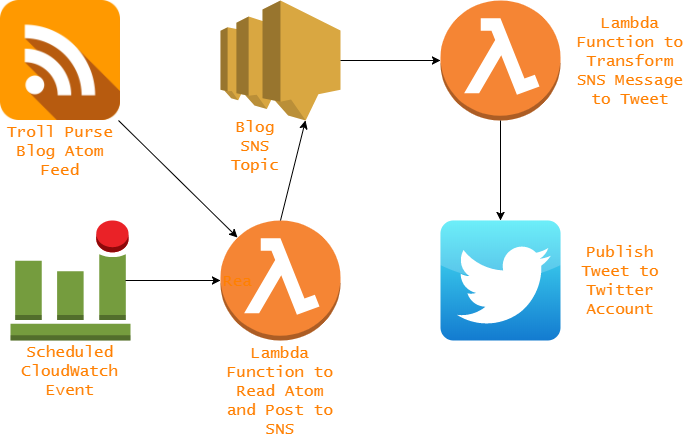Automated Tweets from Atom Feeds with Lambda
As mentioned before, Troll Purse loves automation. One process at Troll Purse that was not automated was the Tweeting of Blog updates to the Troll Purse Twitter account. Orignally, Troll Purse used Hoot Suite to send out updates to multiple social channels at once. This was still a manual process that took time for something so repetitive.
Solving the Problem
While Hoot Suite is still useful, Troll Purse set up an environment using AWS Lambda and AWS SNS.
The Design

The overall design is fairly simple. It is listed out in steps below:
- An AWS CloudWatch Scheduled event is configured to execute on a cron schedule.
- The event is handled by a Lambda event that reads the data from the atom feed endpoint.
- The Lambda then converts the feed data from XML to JSON, gathering only the required information for the message.
- The Lambda publishes this update to an SNS topic.
- A new Lambda is triggered by publishes to the specified SNS topic.
- The new Lambda converts the
Bodypayload of the SNS message into a Twitter tweet message. - The Lambda publishes the tweet using the CoreTweet Twitter library.
The Lambda Codes
Writing code is always a joy. So, here is the code for the Atom Parsing to JSON Lambda. Note: This Lambda uses a Troll Purse internal library for the object, so if you are to copy this, you will need to define your own BlogContentUpdated and ParsedAtomEntry objects. For an example on how to parse RSS and Atom feeds, this was a useful link to follow.
public async Task<string> FunctionHandler(dynamic input, ILambdaContext context)
{
try
{
var request = await WebRequest.CreateHttp(FeedURL).GetResponseAsync();
var latestAtom = XDocument.Load(request.GetResponseStream());
var latestEntry = latestAtom.Root?
.Elements()
.FirstOrDefault(element => element.Name.LocalName.Equals("entry"));
if (latestEntry == null)
{
return null;
}
var entry = new ParsedAtomEntry(latestEntry);
var updateMessage = new BlogContentUpdated(entry.LinkHREF, entry.Title.Length > BlogContentUpdated.MaxTitleLength ? entry.Title.Substrin(0,BlogContentUpdated.MaxTitleLength) : entry.Title,
Regex.Replace(entry.Content, "<.*?>", String.Empty).Substring(0, BlogContentUpdated.MaxSnippetLength));
var publishRequest = new PublishRequest
{
TopicArn = Environment.GetEnvironmentVariable("topic_arn"),
Message = JsonConvert.SerializeObject(updateMessage)
};
var response = await SNSClient.PublishAsync(publishRequest);
return response.MessageId;
}
catch(Exception e)
{
context?.Logger.LogLine("Error with syndication.");
context?.Logger.LogLine(e.Message);
context?.Logger.LogLine(e.StackTrace);
return null;
}
With that. The Lambda triggered by the SNS notification uses a few short lines of code in the function definition.
public async Task<string> FunctionHandler(SNSEvent input, ILambdaContext context)
{
try
{
var messageJSONString = input.Records[0]?.Sns.Message;
context?.Logger.LogLine($"Received({input.Records[0]?.Sns.MessageId}): {messageJSONString}");
if (messageJSONString != null)
{
var magicCharCountForFormat = 7;
var messageContent = JsonConvert.DeserializeObject<BlogContentUpdated>(messageJSONString);
var snippetLength = MaxTweetLength - messageContent.PostTitle.Length - messageContent.PostLink.Length - magicCharCountForFormat - GameDevHashtags.Length;
var tweetStatus = $"{messageContent.PostTitle}. {messageContent.ContentSnippet.Substring(0, snippetLength)}... {GameDevHashtags} {messageContent.PostLink}";
var token = Tokens.Create(Environment.GetEnvironmentVariable("consumer_key"),
Environment.GetEnvironmentVariable("consumer_secret"),
Environment.GetEnvironmentVariable("auth_token"),
Environment.GetEnvironmentVariable("auth_secret"));
var response = await token.Statuses.UpdateAsync(tweetStatus);
return response.CreatedAt.ToString();
}
else
{
return null;
}
}
catch(Exception e)
{
context?.Logger.LogLine("Unable to Tweet SNS message");
context?.Logger.LogLine(e.Message);
context?.Logger.LogLine(e.StackTrace);
return null;
}
}
The majority of the work is done by the CoreTweet Library. Also notice that there are no hardcoded auth tokens - a good practice, especially since environment variables for lambda can be stored as encrypted values.
Core Tweet
Enough has been said about Core Tweet that it warrants it’s own section. Setting up Core Tweet was extremely simple. It involved two multipart steps. The steps were to configure Twitter to enable app authorization for your account and install the Core Tweet Nuget Package for .Net Core.
Here are the steps simplified:
- Go to the Twitter Apps website.
- Log in to the Twitter account you want to have the Tweets pushed to.
- Select Create New App Button.
- Follow the Instructions
- Under Application Settings Authorize the App the access the account you are logged into.
- Setup your Lambda
- Upload your function or create it inline
- Save your keys and access tokens from Twitter as encrypted Lamnda Environment Variables
Conclusion
Indeed, Troll Purse loves automation. Especially if it increases workflow and customer engagement. By automating the process of updating customers of new blog posts, Troll Purse is able to spend more time writing useful blog tutorials such as this and making games.
